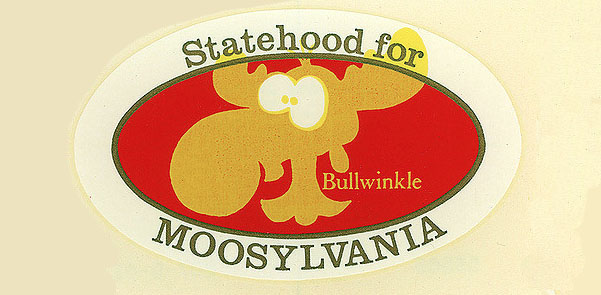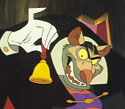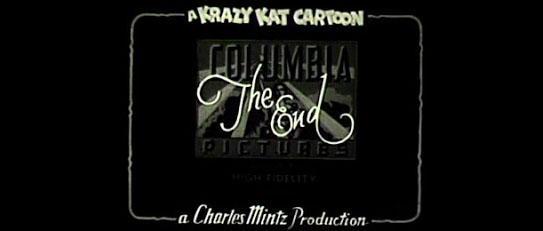Maltin Meets Ward. When I was writing for Animation News (published by Terry Thoren and edited by John Cawley) in 1986-87, I was constantly looking for something interesting for features I was writing and film historian Leonard Maltin was kind enough to share the following with me that I never got around to using but recently found as I was rummaging through some other material.
Leonard wrote animation producer Jay Ward a letter when he was twelve years old and “he wrote back on wonderful embossed Bullwinkle stationery!” Thus began a lively and very friendly correspondence. I was in heaven. He put me on his mailing list and I received some of the famous Jay Ward promotional packets including the Statehood for Moosylvania kit.

“When I was eighteen, I made my first trip to California and arranged to visit his studio. Jay couldn’t have been nicer. He heralded my arrival at the Sunset Boulevard office by plugging in the calliope that stood in the reception area. The damn thing shook the entire building!
“I also remember one of his artists walking by to get approval of his design for the first Bullwinkle watch which I subsequently bought. The only problem, as he explained, was that you couldn’t clearly tell what time it was unless it happened to be 6:30 which was true. Jay replied, if you wear a Bullwinkle watch you don’t really care what time it is anyway.
“Some years later I visited the studio when the only production going on was an occasional Cap’n Crunch commercial but I spent some time with staff director Bill Hurtz. As he was walking me around, we turned a corner and bumped straight into Jay. I re-introduced myself and he gave me a friendly ‘hello’. Realizing I had my camera with me, I asked if he’d mind my taking a picture of him.
“Never losing his smile, he answered, ‘Yes’. I chuckled, thinking he was kidding and he sensed this. ‘No, I really mean it,’ he said gently and I dropped the subject. This is a man who had an evening devoted to him at the Academy of Motion Picture Arts and Sciences with twelve hundred rabid fans, many of his colleagues and most of his family in attendance….except for Jay.”
Wouldn’t it be great to have Leonard share a selection of those Jay Ward letters? I bet he even has other treasures like those as well. Maybe it could even be a new column for Cartoon Research.
Editor’s Note: Leonard has his own blog and posts frequently about animation – past and present. I highly recommend it!
 Great Mouse Detective. In the October 1986 issue of American Cinematrographer magazine, supervising animator Hendel Butoy talked about Disney’s The Great Mouse Detective (1986): “This was truly an animator’s film because the characters are richer and more interesting. The Black Cauldron (1985) was considered more of a layout artist’s picture, whereas ours put emphasis on personality. The animators were turned loose to explore any number of possibilities. As a result, we were able to have more fun with the characters – doing it to please ourselves – so then the audience could have more fun as well.”
Great Mouse Detective. In the October 1986 issue of American Cinematrographer magazine, supervising animator Hendel Butoy talked about Disney’s The Great Mouse Detective (1986): “This was truly an animator’s film because the characters are richer and more interesting. The Black Cauldron (1985) was considered more of a layout artist’s picture, whereas ours put emphasis on personality. The animators were turned loose to explore any number of possibilities. As a result, we were able to have more fun with the characters – doing it to please ourselves – so then the audience could have more fun as well.”
Toei Doga. In 1984, the Toei Doga studio in Japan employed roughly a thousand animators who both worked in the studio or at home as sub-contractors. They worked on animation paper about a third smaller than the American standard. The studio turned out a half hour show every DAY, a full-length feature every two and half months and in its spare time, did work on American shows for Marvel and DIC. The average worker made about two hundred dollars a week but the company paid for all health expenses, weddings and funerals and generally provided lifetime employment for the life of the company. The studio operated 24 hours a day, seven days a week to make its commitments.

Paul J. Smith. When Disney composer Paul J. Smith passed away in January 1985 at his Glendale, California home of a heart attack brought on by complications of Alzheimer’s Disease, his obituary stated that he studied music at the Bush Conservatory in Chicago before joining Disney in 1934. He was survived by his son, adopted daughter and three brothers, two of whom, Arthur and George were studio musicians.

Space Ace. The original storyboards and game plan for the Don Bluth videogame Space Ace (1984) had Dexter and Kim the same age and that Dex would “grow” into Ace in a similar fashion as Billy Batson and Captain Marvel. However, the game partners realized that one of the biggest selling points in the previous Bluth videogame, Dragon’s Lair (1983) was the sexy Princess Daphne, so it was decided to make Kimberly older and more physically appealing and thus the hero had to be older. That meant that Ace had to appear first and be hit by the Infanto Ray and become Dex (voiced by Will Finn).
Don Bluth was the electronically altered voice for the villainous Commander Borf and animator Lorna Cook voiced Kimberly. On a side note, Bluth tried to tell dealers to buy cels of Daphne and Kimberly but they balked thinking that kids only wanted the male hero characters. By the time, the dealers realized differently, the good cels of the female characters had already been sold through Bluth’s fan club and conventions.
Animation History? From Fortune magazine May 1936: “Charles Mintz made his first film coup in 1919 with a picture that depicted the horrors of venereal disease. It was shown one day ‘For Men Only’ and the next day ‘For Women Only’. It caused men and sensitive women to faint and made $15,000 for Mr. Mintz. With this $15,000, he began making Felix the Cat cartoons. Walt Disney was there from 1923 until 1928 when it became clear that no studio was big enough to hold both Mintz and Disney, so Disney left with no hard feelings.
“The Mintz business acumen is curiously marked with a social consciousness that always comes out in his cartoons. After the 1929 crash, he produced Lambs Will Gambol whose locale was the stock exchange and whose characters were lambs and bulls and bears. Technocracy inspired Technoracket: a farmer who replaced all his help with machinery was vastly pleased until the discharged help crossed wires caused the cow to lay eggs and the pig to produce cheese, and got their jobs back.”



 Jim Korkis is an internationally respected animation historian who in recent years has devoted his attention to the many worlds of Disney. He was a columnist for a variety of animation magazines. With his former writing partner, John Cawley, he authored several animation related books including The Encyclopedia of Cartoon Superstars, How to Create Animation, Cartoon Confidential and Get Animated’s Animation Art Buyer’s Guide. He taught animation classes at the Disney Institute in Florida as well as instructing classes on acting and animation history for Disney Feature Animation: Florida.
Jim Korkis is an internationally respected animation historian who in recent years has devoted his attention to the many worlds of Disney. He was a columnist for a variety of animation magazines. With his former writing partner, John Cawley, he authored several animation related books including The Encyclopedia of Cartoon Superstars, How to Create Animation, Cartoon Confidential and Get Animated’s Animation Art Buyer’s Guide. He taught animation classes at the Disney Institute in Florida as well as instructing classes on acting and animation history for Disney Feature Animation: Florida.




















































I never understood why there wasn’t a sequel to “Great Mouse Detective.” It would have made for a fine film series or television series.
A propos of nothing, in my college days I discovered the book “Basil of Baker Street” in the children’s section of a local bookstore. I started to read it, but there were so many references to Sherlock Holmes that I decided to wait until I had read the Holmes stories, which I so far had not done. Once I started reading the original Sherlock Holmes stories by Sir Arthur Conan Doyle, I became hooked on them as well as on detective fiction in general. But by the time I was ready to read “Basil of Baker Street” the film of “The Great Mouse Detective” came out so I watched that and absolutely loved it. By then, I didn’t feel as keenly the desire to read the book, which felt too juvenile for me at that point, despite my appreciation of the film. So ultimately I never got to it. But the film remains high on my list of Disney favorites. I love the fact that Toby the dog, who actually appears in at least one of the Sherlock Holmes stories, plays an important role in “The Great Mouse Detective.”
WILLIAM CONRAD: “Don’t fail to miss our next exciting episode, Photo Oops or Watch the Nerdy!”
I can only imagine how terrific it must have been to visit Jay Ward Studios, especially since fans were passing around cassette tapes of scores for some major Jay Ward cartoons, the kind of stuff that should have been extras on the various DVD sets. A BULLWINKLE watch that doesn’t work? Kinda sounds like the kind of invention by that old clock-maker in one of the FRACTURED FAIRY TALES.
The DVD set had potential.
Interesting about Toei, later on (reading off of AniPages’ forums) they were getting paid $500 a month for the original Dragon Ball but $5000 a month for G.I. Joe (hence why Japanese studios started doing American outsourcing in the first place, it paid more, when Korean studio have no difference between payment between anime, western animation and local project hence why everyone switched to Korean studios), the fact that they got a $300 raise a year later tells how bad post-Miyazaki Toei was.
http://www.pelleas.net/forum/viewtopic.php?p=9678#p9678 (Why Japanese studios started doing American outsourcing in the first place).
No doubt studios like Toei were probably hurting in the post-bubble years, too.
At Chris Sobieniak: Toei has been hurting ever since their original staff left because Toei wanted to become Filmation instead of UPA (Disney in it’s earliest years), when they had their moments after Miyazaki left (Ojamajo Doremi) the lack of their original staff is clear that Toei jumped shark after 1972.
http://www.pelleas.net/aniTOP/index.php/toei_doga
http://www.pelleas.net/aniTOP/index.php/toei_doga_pt_2